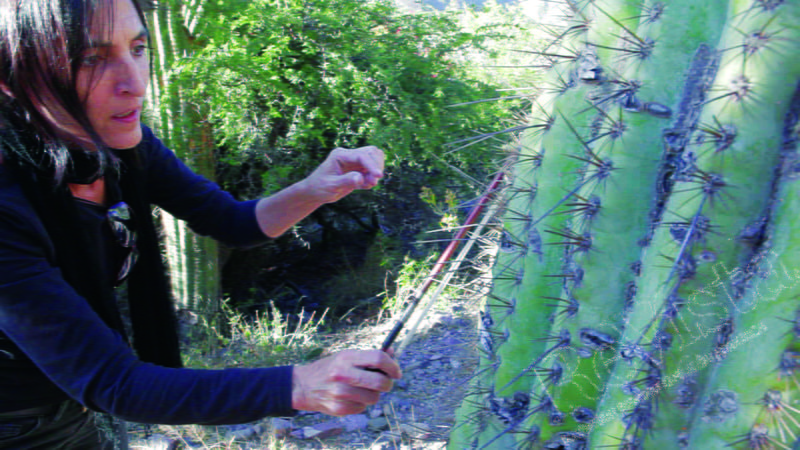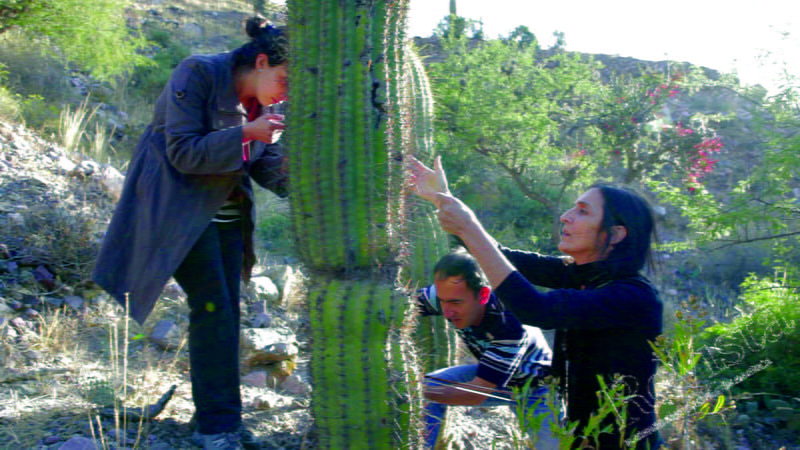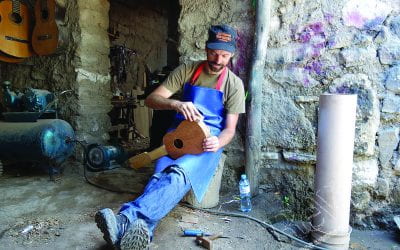The Cactus Song
Beyond Silence in the Argentine Deser

Argentine experimental composer Carmen Baliero makes music on a gigantic cactus in the desert. Photo by Julien Hogert.
Can cactuses make music? The answer is definitely yes.
Argentine experimental composer Carmen Baliero took a look at cardones, a species of gigantic cactus (some are over 32 feet) that flourish in the Quebrada de Humahuaca, in Jujuy, Argentina. Seeing these amazing plants, Baliero imagined what they would sound like.
The three basic sounds that come from these cactuses, filled with water, are from plunking the thorns (which have different pitches depending on their sizes); from drawing a bow across these thorns; and from stroking the “body” of the plant with drumsticks. For these sounds to have a better projection, they have to be amplified with contact microphones (pickups or piezos) placed on the cactus. These microphones (as well as the eventual lighting and use of electricity in general) cause minimum disruption to both the cactus and the environment.
The cardones are silent and they live in a silent geography, a silent landscape. They grow on hillsides, emerging from biologic residues in the land. This means that under each cactus there is the residue of something that was once alive, bringing to mind the idea that the cactus will not only make sounds but also speak. Baliero voices the possibility of a “hidden discourse of the cardón.”

Carmen Baliero, Fernando Ariki and author Violeta Nigro Giunta perpare a cardón for playing. Photo by Julien Hogert.
When talking to people from Jujuy, I often heard them mention an unlikely historical anecdote: that during the Spanish conquest, people used to dress up the cactuses to swell the appearance of their ranks. Observes Baliero, “The cardones look like soldiers; they appear to be the guardians of history. They stand like sentinels everywhere, watching. Because if underneath lie biological residues, this means that you can have a Spaniard, a coplera [local popular song writer], a guaraní, a llama. Underneath, there is history, and that’s where the cactus comes from. It is like a witness or buoy that indicates where there was life. I think that for any jujeño and especially any humahuaqueño, from the region of the Quebrada, a cardón is a part of your family.”
Baliero emphasizes the idea that musical discourse should not be exclusive in any way (be it an orchestra of Germans or of copleras), and that “any musician with a sensibility can play a cactus rather well.” In a private in-depth interview on April 2014, she observed, “If the coplera wants, for example, to do contemporary music, and play Luigi Nono, why shouldn’t she? A poor person must be folkloric, s/he cannot be modern, and that’s how it is. That is why I say we have to mix up, and that is for me a cultural action, to mix different discourses and make a single one.”
In 2003, UNESCO declared that everything in the Quebrada, including the cardones, was a World Heritage site. As a protected species, cardones cannot now be used, for example, for furniture or in house construction. But recently a new plague, a butterfly that migrated to the area, began to lay eggs in the cardones, eating them from the inside and threatening them with extinction. Treatments are not giving the desired results. This is the urgency of the project, when rehearsals begin in 2016: for someone to effectively cure the cardones. As Baliero says: “I believe one must be with the cardones to cure them. They have to become visible. And since they are silent, we must make them talk.”
Winter 2016, Volume XV, Number 2
Violeta Nigro Giunta is a Ph.D. Candidate at the École des Hautes Études en Sciences Sociales (EHESS/CRAL) in Paris. She is also a pianist and performer. She can be reached at <violetanigrog@hotmail.com>.
Related Articles
Beyond Bolaño: The Global Latin American Novel
I often wonder what life would have held for the late Chilean writer Roberto Bolaño if he had not passed away due to liver complications more than a decade ago. This year he would have…
Notes on Mexican Rock
English + Español
Since the 1960s, there’s been a booming underground rock scene in Mexico. It defines itself as countercultural, but not in absolute opposition to the mainstream—although sometimes it…
Nature’s Sonorous Politics
English + Español
There’s no indigenous political movement in Andean Peru. This, at least, has been the consensus view of scholars since the 1990s, when protests organized by indigenous parties shook the…




